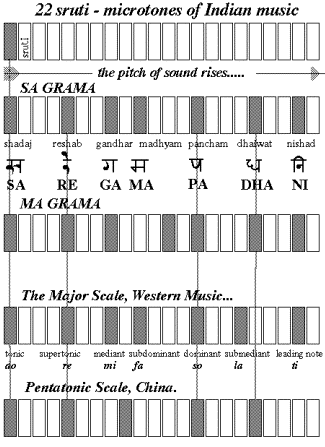Indian
Music Theory
|
- Modern
Indian Classical Music (and Dance) theory
had its beginnings at least five thousand
years ago. Across the intervening
centuries it has evolved into a complex
system based in rhythm and melody.
Melody is perhaps the most critical
element of Indian music. A system of
melodic ideas called RAGA drives musical
compositions. Each RAGA can be thought
of as an 'individual' with its own
'personality'.
It is helpful, in appreciating RAGAS, to understand
how the Indian equivalent of Western
'scales' work. The ways the pitches of
scales move up and down shapes the
'profiles' of each RAGA.
- The OCTAVE
comprises twenty two equal divisions
called SRUTI. These may be combined and
re-grouped into twelve SWARA which may be
similar in the ways they move to the
twelve semitones of Western scales. Like
those of Western scales too, seven are
regarded as being 'primary' while the
other five the 'flats' and 'sharps' of
the seven primary SWARAS.
The seven primary SWARA are illustrated
here in Hindi script. They are SA for
SHADAJ, RE for RESHAB, GA for GANDHAR, MA
for MADHYAM, PA for PANCHAM, DHA for
DHAIWAT, and NI for NISHAD.
- The
distance between a basic pitch or shadaj
and that created by doubling its
frequency (or 'vibrations') is called an
octave in west-centric music. In Indian
music this octave is divided into twenty
two smaller intervals of roughly equal
size each called sruti.
|

|
- Sruti are
grouped together unequally to form, in
diverse combinations of sruti, twelve
basic pitches called swara. Seven of
these, the shuddha swara, predominate and
together form the basic scale called
saptak. These correspond loosely to the
seven basic pitches of the major scale
which most west-centric musicians are
familiar with.
|

|
- The names
given successively to the shuddha swara
are: shadaj (sa), reshab (re), gandhar (ga),
madhyam (ma), pancham (pa), dhaiwat (dha),
and nishad (ni).
|
|
- The
remaining five swara are variants of some
of the seven shuddha swara. They are
called vikrit. When the full scale is
notated in succession fall as follows:
|

|
| Here re, ga,
dha and ni are lowered pitch-wise and me is a
raised variant of ma. Sa and pa are never changed.
|
For the sake of
making comparisons in future discussion and
because they correspond roughly:
- SA will be
treated as being like DOH in Tonic Solfa
- RE will be
treated as being like RE in Tonic Solfa
- GA will be
treated as being like MI in Tonic Solfa
- MA will be
treated as being like FA in Tonic Solfa
- PA will be
treated as being like SOH in Tonic Solfa
- DHA will be
treated as being like LA in Tonic Solfa
- NI will be
treated as being like TI in Tonic Solfa
|

|
The twelve
swara are used in diverse combinations to create
special scale structures called thatt . Two rules
govern the construction of thatt :
- i] Sa and
pa must be included and cannot be
sharpened or flattened.
- ii Five of
the ten remaining swara must be used.
In this way
thirty two thatt are possible. Beginner musicians
are usually taught ten of these first, in this
order:
|
- 1.
SA RE GA MA PA DHA NI
- 2.
SA RE GA MA PA DHA ni
- 3.
SA RE GA me1 PA DHA NI
- 4.
SA RE ga MA PA DHA ni
- 5.
SA re GA MA PA dha NI
- 6.
SA re GA me1 PA DHA NI
- 7.
SA RE ga MA PA dha ni
- 8.
SA re GA me1 PA dha NI
- 9.
SA re ga MA PA dha ni
- 10.
SA re ga me1 PA dha NI
|
- Bilawal
thatt
- Khammaj
thatt
- Yaman
thatt
- Kafi
thatt
- Bhairav
thatt
- Marwa
thatt
- Asawari
thatt
- Purvi
thatt
- Bhairavi
thatt
- Todi
thatt
|
|
| Each thatt is
more than just a scale; by the manner in which it
is used it becomes the basic melodic foundation
for each raga. |

|
| The raga is the
melodic tenet which maintains Indian classical
music's melodic identity. The following rules
inform raga: |
- Each raga
is derived from a thatt .
- Several
raga may be based on one familial thatt.
- Sa must
always be included.
- Either ma
or pa (or both) must be included.
- A shuddha
swara and its vikrit are not normally
performed one after the other.
|
- Five or
more fixed pitches may be played in each
direction when the music rises or falls
in pitch. Those played going up are not
necessarily the same as those played
descending.
|
A raga is not just a 'key'
but an emotion, mood or feeling expressed
in sound. The laws outlined above help to
give each raga its own profile}{ much in
the way that our facial profiles make
each of us appear individual and unique.
This profile or contour is called parakh.
|
| Although there
were once almost twelve thousand different raga,
now only one hundred and thirty two are
considered to have real artistic potential. These
are each designed for a specific context, such as
for seasons or for times of the day. |

|
| Linked with the
raga in tempo and rhythm are the tala. Because
they are much less numerous one can 'support'
several raga. Tala are important in many other
ways, since the essence of Indian music is both
rhythmic and melodic. |